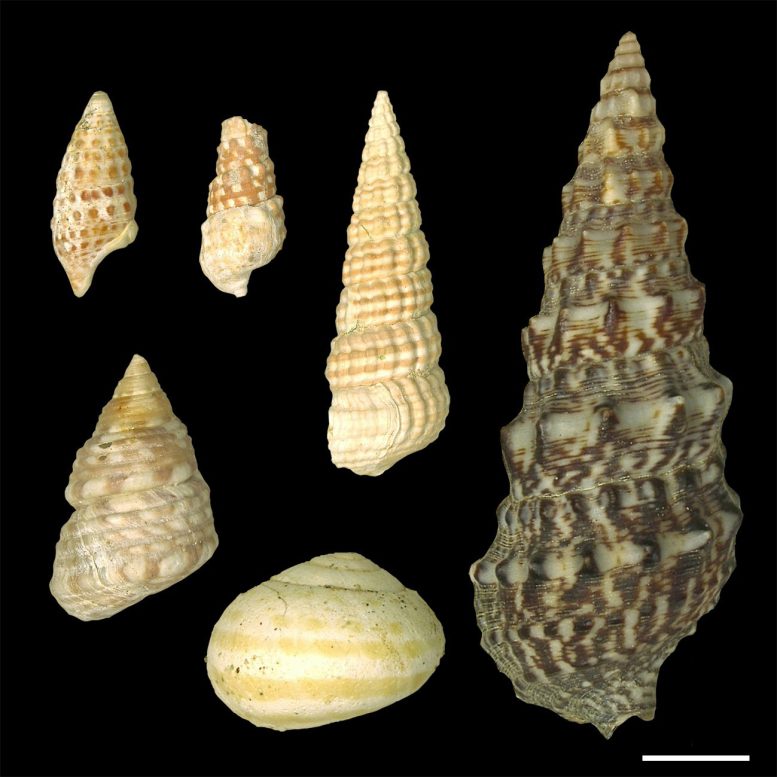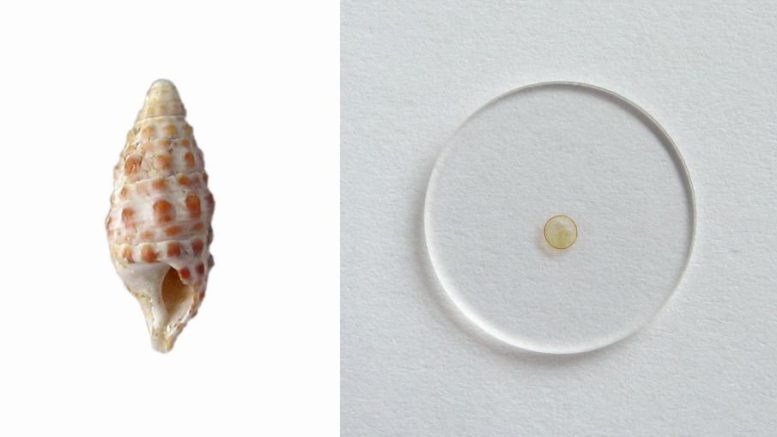
Colored fossil snail shells (left) and a snail shell from modern times (large specimen on the right). Credit: Klaus Wolkenstein
Scientists present the world’s first evidence of intact polyene pigments in fossils.
Snail shells are often colorful and strikingly patterned. This is due to pigments that are produced in special cells of the snail and stored in the shell in varying concentrations. Fossil shells, on the other hand, are usually pale and inconspicuous because the pigments are very sensitive and have already decomposed. Residues of ancient color patterns are therefore very rare.
This makes this new discovery by researchers from the University of Göttingen and the Natural History Museum Vienna (NHMW) all the more astonishing: they found pigments in twelve-million-year-old fossilized snail shells. These are the world’s first pigments from the chemical group of polyenes that have been preserved almost unchanged and found in fossils. The study was published in the journal Palaeontology.

Fossil shell of Pithocerithium rubiginosum (height is 1.5 cm) from the Miocene sediments of Nexing in Austria (left) and isolated reddish polyene pigments on calcium fluoride disc (diameter of disc is 2 cm) (right). Credit: Klaus Wolkenstein
Discovery and Analysis
Paleontologists from the NHMW found snail shells of the superfamily Cerithioidea in Burgenland, Austria. The snails lived there twelve million years ago on the shores of a tropical sea. Professor Mathias Harzhauser at NHMW, who was involved in the discovery, explains: “It was unclear whether the patterns of reddish color were from the original shell or were formed by later processes in the sediment.”
Researchers at Göttingen University’s Geoscience Center solved the mystery. They analyzed the pigments using Raman spectroscopy. This involves irradiating samples with laser light. The scattered light reflected from the sample can be used to clearly identify chemical compounds. They detected pigments in the fossilized shells that belong to the polyene group of chemicals. These are organic compounds that include the well-known “carotenoids”, which are responsible for producing the vibrant red, orange, and yellow colors seen in birds’ feathers, carrots, and egg yolks, for instance.
Dr. Klaus Wolkenstein, who led the study and has been researching the chemistry of fossil pigments at Göttingen University for many years, explains: “Normally, after such a long period of time, the best we can hope for is that there are traces of degradation products of these chemicals. If degraded, however, these compounds would be devoid of color. So, it was really surprising to discover these pigments, preserved almost intact, in fossils that are twelve million years old.”
Reference: “Detection of intact polyene pigments in Miocene gastropod shells” by Klaus Wolkenstein, Burkhard C. Schmidt and Mathias Harzhauser, 1 February 2024, Palaeontology.
DOI: 10.1111/pala.12691









Be the first to comment on "Scientists Have Discovered the World’s First Polyene Pigments in Fossils"